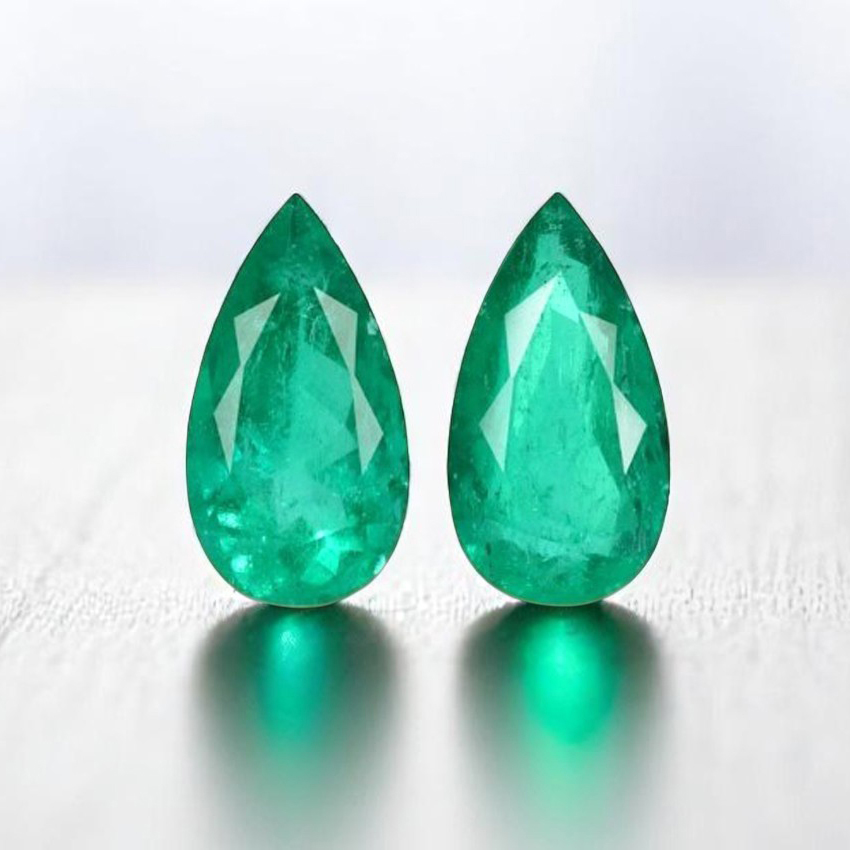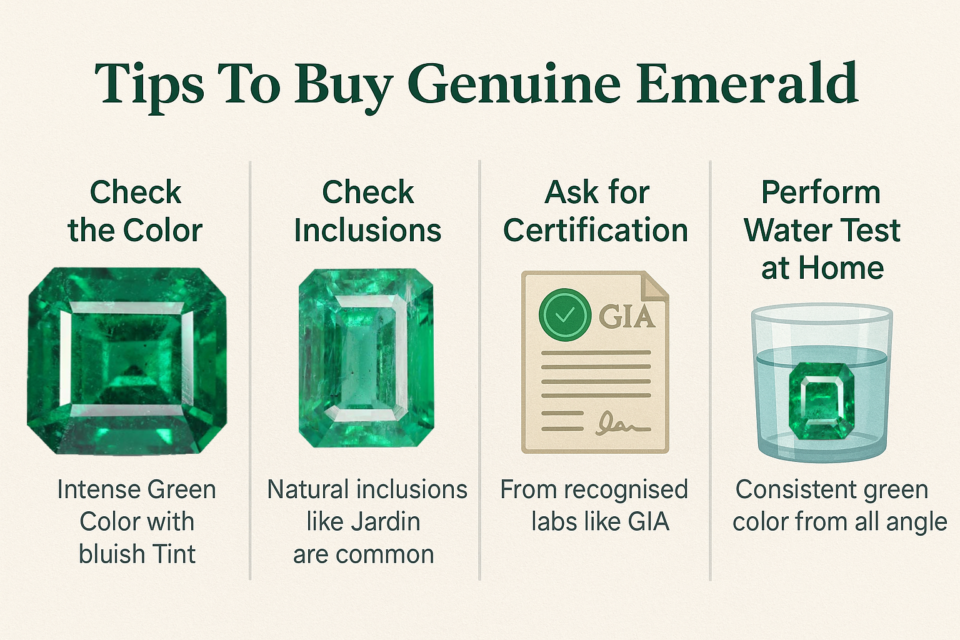Emerald is a precious gemstone loved by royalty for centuries. As the major mines get depleted, the rarity of emerald stone is increasing. With time, the presence of fake and lab created gemstones is growing the market, duping customers of millions worldwide.
If you are a gemstone collector or just purchasing an emerald for personal reasons, knowing how to spot a fake emerald is essential to get the real deal. Our easy-to-read guide walks you through the essential signs that fake emerald possesses and provides you with the knowledge to distinguish between fake and original ones.
Emerald and Its Characteristics
- Mineral: Beryl
- Chemical formula (Be₃Al₂(SiO₃)₆)
- Color: Pale green to vivid green with a bluish tint
- Emerald hardness: 7.5
- Luster: Vitreous
- Treatment: Oil-treated to enhance color and clarity
- Best origin: Colombia, Brazil, and Zambia
- Emerald stone signifies love, growth, and prosperity. Used as an engagement ring and astrological stone in many cultures.
How to Spot a Fake Emerald: 6 Easy Tips to Know
- Observe the Color
Emerald stone is characterised by a mesmerising green color with a bluish tint. In some pieces, like those sourced from Brazil, it is characterized by green color with a yellow tint. The natural emerald color is due to the presence of trace elements, mainly chromium.
However, if the color is due to iron as a trace element, then it is probably green beryl. This gemstone is not an emerald but is often sold under its name.
Pro Tip: Green beryl is distinguished from emeralds by color. Where the former has a pale green color, the latter has a vivid green hue.

2. Use of Chelsea Color Filter
The Chelsea color filter is a gemological tool that helps identify gemstones. It is mainly used to identify gems like sapphire stone, emeralds, and aquamarine stone. This filter works on the concept of selective light transmission. It absorbs light of a certain wavelength and transmits deep red and yellow-green light.
For instance, when you observe the emerald stone under the Chelsea filter, you will see a bright red color being transmitted. This is due to the presence of high chromium (responsible for giving the green color to the stone).
Pro Tip: Synthetic emeralds show a super bright red color under this filter. This is the easiest and most effective way to identify natural emerald stone from its synthetic counterparts.
3. Clarity as a Key Indicator of Authenticity
To identify real gemstones from fake ones, inclusions play a key role. Emerald inclusions are referred to as Jardin, which means “garden” in French. When closely observed, they appear as a green garden and are hence named so. Emerald inclusions also give you an idea about their origin.
For instance, needle-like inclusions are found in gemstones from Siberia. Two-phase inclusions are a characteristic feature of gems from Pakistan, whereas Colombian emeralds feature three-phase inclusions.
Pro Tip: Aventurine quartz is often sold as a natural emerald gemstone. This quartz is very affordable and mimics emerald color. Mica inclusions in aventurine quartz give the green color to the stone. If you observe it from a 10X loupe, you will find green dots which are actually green minerals.
So whenever you buy an emerald stone, observe the inclusions. Make sure you don’t end up purchasing a fake one, like quartz, or even YAG or glass. Inclusion-free emeralds are very rare and account for high prices. YAG (Yttrium Aluminum Garnet) is made in the lab and is free from inclusions.
Similarly, a green glass with no inclusions is often sold in the market as a real gemstone. They mimic the beauty of natural emerald stone, but if you look for the inclusions, you will find differences.
4. Beware of Composite Gemstones
A composite emerald is formed from different materials stacked together. Referred to as Soude emerald, these gems mimic natural emeralds and are more affordable.
This composite gemstone is formed with a colorless base and top. A thin slice of emerald in the center appears to be a natural gem itself.
Pro Tip: Spotting fake emeralds is a tricky task with these composite counterparts. Perform a water test to identify the real emerald. For this, take a glass of water and submerge the gemstone in it. In a fake gemstone, glass bubbles will be seen.
When you diffuse light, you will see the difference in luster. While the top base (can be of any material other than emerald, like garnet quartz) shines brighter, the bottom base has lower luster (can be glass).

5. Perform Water Test
Submerge the emerald stone in water. You will see color zoning in genuine emerald, whereas in synthetic or fake emerald, there is even color distribution. The water test is helpful, but not an authenticated answer to how to spot a fake emerald gemstone.
Pro Tip: Always look for authentic gemstone certificates. The best emerald certificates are from IGI and GIA. These certificates are authenticated proof stating your gemstone as real. A genuine certificate also indicates the gemstone treatment, grading, and quality.
6. Flash Test
Burn a natural emerald on a flame for 30 seconds and dip it in water. The synthetic counterpart will break, whereas the natural gem will not.
To spot a fake emerald is tricky, and hence it is always important to buy gemstones from reputed sellers like Navratan. We offer you a wide collection of emeralds from different sources like Colombia, Brazil, and Zambia.

